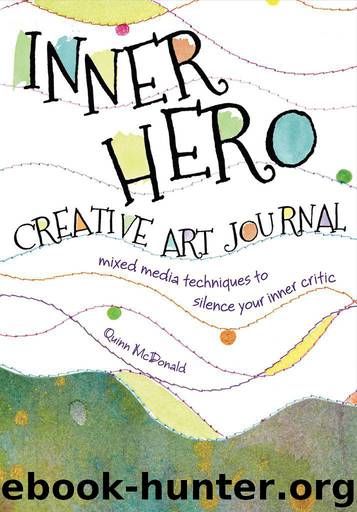Inner Hero Creative Art Journal: Mixed Media Messages to Silence Your Inner Critic by McDonald Quinn

Author:McDonald, Quinn [McDonald, Quinn]
Language: eng
Format: epub
Publisher: North Light Books
Published: 2014-01-23T22:00:00+00:00
Collecting Natural Elements
1. Collect pieces from your own yard or from a public area. Never pick leaves from trees or blossoms from a private yard.
2. If you pick leaves, seedpods, small branches (they make interesting writing implements) or pebbles from the ground, look before you touch. Dogs wander in the same area that you do. Feathers are tempting, but all feathers of migratory birds and endangered birds are illegal to own in the U.S. (Migratory Bird Treaty Act, 16U.S.C. 703-712). You may collect feathers from feral pigeons, house sparrows, nonmigratory pheasants and starlings safely. You can also purchase dyed feathers in craft stores.
3. Seedpods, leaves and blossoms are fragile. Choose leaves in good shape. Dry leaves can work as long as they are not brittle. Carry a hard-shelled container (an old sunglasses case works well). Or use a small, acid-free sketchbook, tucking the leaves or blossoms between pages, one to a page. When you are done, close the sketchbook with a rubber band.
4. When you get home, wipe the leaves on both sides with a damp paper towel. Wash rocks as well. Not all flower petals or blossoms can be rinsed, but sturdy petals (roses, for example) can be sprayed with water, then blotted dry, then left to dry completely.
5. When the leaves and petals are completely dry, place the leaves on acid-free, heavy paper (several sheets from the sketch pad will work). Do not allow the leaves to overlap. If the leaves are not completely dry, they will mold and be unusable. The same is true for petals. Don’t mix leaves and petals on the same page; their different thicknesses will cause the thinner flower petals to shrink and warp. Put two plain sheets between each layer of flowers or leaves to distribute the moisture. Put the stack on a flat surface and pile some heavy books on it. Leave it for a week before peeking.
Saving leaves, petals, seeds and twigs is a seasonal activity. Use spring, summer and fall to gather materials so you will have them for winter. Pick flowers just before their peak, in the morning, and take them apart as soon as you get home. Discard the part of the flower that has pollen on it as it will stain paper and other petals. Cantaloupe and honeydew melon seeds make great design elements, but they must be completely dried before use. Once they are dry, try spraying them with a gold or pearlescent ink, then letting them dry again before use.
Download
This site does not store any files on its server. We only index and link to content provided by other sites. Please contact the content providers to delete copyright contents if any and email us, we'll remove relevant links or contents immediately.
On Writing A Memoir of the Craft by Stephen King(4863)
The Doodle Revolution by Sunni Brown(4685)
A Simplified Life by Emily Ley(4099)
Mummy Knew by Lisa James(3631)
Marijuana Grower's Handbook by Ed Rosenthal(3620)
Better Homes and Gardens New Cookbook by Better Homes & Gardens(3525)
Figure Drawing for Artists by Steve Huston(3381)
Paper Parties by Erin Hung(3371)
Draw Your Day by Samantha Dion Baker(3289)
The Genius of Japanese Carpentry by Azby Brown(3224)
Japanese Design by Patricia J. Graham(3109)
The Code Book by Simon Singh(3074)
Dangerous Girls by Haas Abigail(2976)
Lions and Lace by Meagan Mckinney(2924)
The Curated Closet by Anuschka Rees(2913)
How to Make Your Own Soap by Sally Hornsey(2827)
The Checklist Manifesto by Atul Gawande(2777)
The Wardrobe Wakeup by Lois Joy Johnson(2732)
Zero to Make by David Lang(2726)
